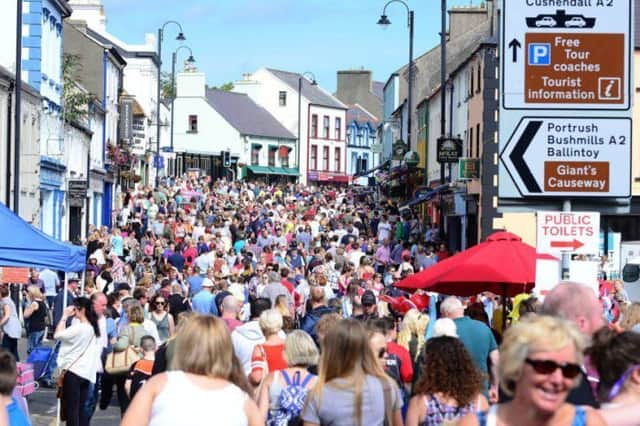Everything you want to know about Auld Lammas Fair in Ballycastle O


It’ll be launched with a massive fireworks display on the seafront on 27 August, the Sunday night before the festivities begin.
Here are a few stories from eminent travel-writer Mitchell Smyth, now retired in Canada, but originally from Ballycastle.
First, the song, The Oul’ Lammas Fair.
Everyone here knows at least a couple of lines:
“At the Oul’ Lammas Fair, boys, were you ever there,
Were you ever at the fair in Ballycastle O?’’
But what about the man who wrote it?
His name was John Henry McAuley.
Advertisement
Hide AdAdvertisement
Hide AdHe made a living carving intricate models - animals, farm carts, circus wagons, gypsy caravans, from bog oak, in his shop in Ann Street, Ballycastle.
When his hands got tired he’d leave his chisels and punches aside and reach for his fiddle.
The people passing John’s little shop would pause and listen to his jigs and reels.
Then he’d break into song with his own composition:
“Did you treat your Mary Ann,
To some dulse and yellow man,
At the Oul’ Lammas Fair in Ballycastle O?”
That was about 100 years ago.”
One day in the early 1920s a man called Sam Henry, a civil servant in Coleraine whose hobby was collecting local folk songs, stopped by to listen.
Advertisement
Hide AdAdvertisement
Hide AdHe took down the words and transcribed the music on tonic solfa. (This was long before the days of portable recording equipment!).
The Oul’ Lammas Fair got a whole new audience when Sam Henry published it in his weekly column ‘Songs of the People’ in the Coleraine Constitution (later called the Northern Constitution).
John Henry’s song was then issued as a pamphlet.
Soon all of Ulster was singing about the “pretty colleen who set my heart aglow, she was smilin’ at her daddy buying lambs from Paddy Roe.’’
(Paddy Roe was supposedly the nickname of a man called Patrick Rourke, a farmer from Cushendall).
Advertisement
Hide AdAdvertisement
Hide AdMcAuley was disabled after he broke his back in a childhood accident when, for a dare, he jumped off the Glenshesk Bridge into the river.
(Glenshesk is a steep sided glen on the eastern flank of Knocklayde mountain.)
He learned to carve wood and opened his shop in Ann Street, where a historic plaque now marks the spot.
His carvings were renowned.
Sir Roger Casement, the Irish patriot, who often visited relatives at Magherintemple, Ballycastle, commissioned John to carve a bog-oak table for a friend in the Belgian Congo.
Advertisement
Hide AdAdvertisement
Hide AdCasement had been a consular official in the Congo before returning to Ireland and getting involved in the independence movement.
John Henry McAuley died in 1937.
The word Lammas comes from ‘loaf mass’ - traditionally bread baked from the first grains of autumn were placed on the church altar. Farther back, it also has roots in the pagan festival of Lughnasa.
Sorley Boy McDonnell, the County Antrim clan chieftain, is credited with founding the fair in the mid-1500s.
It was first held at the McDonnell castle, Dunanenie, on the headland-location of today’s Castle Point caravan park.
Advertisement
Hide AdAdvertisement
Hide AdWhen a castle was built in what is now Ballycastle Diamond in 1625, the fair moved there, where it remains today.
In the 19th century visitors used to come to the fair from Islay, the Scottish island just 20 miles north of Ballycastle. Hardly surprising, given North Antrim’s blood ties with Islay: the McDonnells came from the island.
In the 1960s Ballycastle attempted to renew that tradition, inviting Islay people to the fair.
Some came, but whereas their ancestors’ journey took half a day, if the wind was right, the 20th century trip lasted two days - a flight to Glasgow, an overnight stay, and then a morning flight to Aldergrove.
Talk about the speed of modern transportation!
Advertisement
Hide AdAdvertisement
Hide AdWireless pioneer Guglielmo Marconi came to the Lammas Fair in 1898.
He was in Ballycastle checking on the work of his assistant George Kemp, who was experimenting with radio signals between Ballycastle and Rathlin for Lloyds of London.
Marconi stayed in the Antrim Arms Hotel overlooking the Diamond.
He arrived on Sunday 29 August, two days before the fair on the Tuesday (it was then a one-day event) and left on 2 September.
Advertisement
Hide AdAdvertisement
Hide AdHe was just 24 but already he had become a world celebrity, having conducted wireless transmissions in London, in the Isle of Wight (ship to shore) and on Salisbury Plain in 1896. (The Ballycastle-Rathlin legend that Kemp’s work for Lloyds there was the first transmission over water is not supported by the facts).
There’s an Irish connection to the Marconi story - his mother was the granddaughter of John Jameson, founder of the Jameson whiskey empire.
When the fair was first held, at Dunanenie, (Irish for ‘the fort of the fair’) it was called ‘margie more’ translated as ‘the great market.’
The fledgling hamlet nearby was called Margytown, after the fair.
Advertisement
Hide AdAdvertisement
Hide AdWhen a castle was built on the edge of what is now the Diamond in Ballycastle, the fair moved there and the town became Baile Chasitil (Ballycastle).
The word ‘margy’ is perpetuated in Ballycastle in the Margy River and Bunamargy, the ruined friary on the outskirts of town.
Details of the Ould Lammas Fair are at visitcausewaycoastandglens.com